Kamares ware
Kamares wares are a distinctive type of Minoan pottery produced in Crete during the Minoan period, dating to MM IA (ca. 2100 BCE). By the LM IA period (ca. 1450), or the end of the First Palace Period, these wares decline in distribution and "vitality".[1] They have traditionally been interpreted as a prestige artifact, possibly used as an elite table-ware.

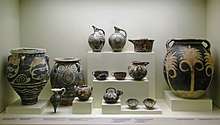
The designs of kamares ware are typically executed in white, red and blue on a black field. Typical designs include abstract floral motifs.
Surviving examples include ridged cups, small, round spouted jars, and large storage jars (pithoi), on which combinations of abstract curvilinear designs and stylized plant and marine motifs are painted in white and tones of red, orange, and yellow on black grounds. At this time, this characteristic type of pottery was produced, with red, orange and white painted decoration on a dark background. The Kamares style was often elaborate, with complex patterns on pottery of eggshell thinness. This small drinking cup shows a simple version. Sets of cups and jugs have been found, and it has been suggested that these may have been used in ritual, though Kamares pottery presumably also graced the dining tables of the First Palaces.
Surprisingly, the first Kamares pottery found in excavation came from Lahun in Egypt, and was discovered by Flinders Petrie. It is now in the British Museum.
Gallery of pieces from Heraklion Archaeological Museum, Crete
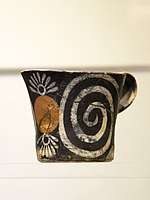 Cup from Phaistos
Cup from Phaistos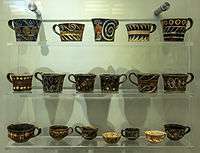 Cups from Phaistos
Cups from Phaistos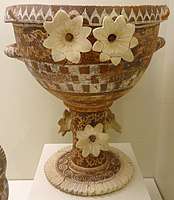
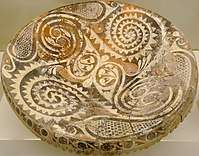 Dish from Phaistos
Dish from Phaistos Pithos with fish in a net, Phaistos
Pithos with fish in a net, Phaistos Phaistos
Phaistos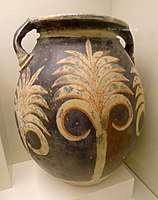

References
- Dickinson, Oliver. 1994. The Aegean Bronze Age. Cambridge University Press.
External links
| Wikimedia Commons has media related to Kamares style. |